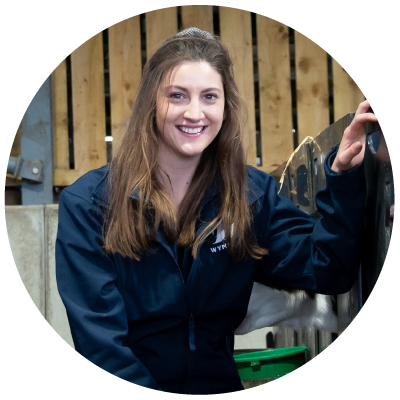We have reformulated Start n Wean formula to increase the starch and energy content, helping to further promote rumen development and maintain gut health.
Our Journey With Start N Wean Reformulation
- By Hannah Padfield
- 11 Apr 2024
- 0 Comments

A farmer’s daughter raised on a dairy farm in Wiltshire, Hannah plays a large role in the calf rearing on the family farm, bringing both a practical and hands-on approach to youngstock. Hannah has recently graduated from Harper Adams University after studying Agriculture with Animal Science.
Following on from her farming background and university placement, Hannah has a keen interest in early calf-hood and transition management, understanding the importance of focusing on young calves and dry cows to maximise the performance of your current and future herd.
We have reformulated Start n Wean formula to increase the starch and energy content, helping to further promote rumen development and maintain gut health.
Posted in Calf & Youngstock
With spring calving fast approaching, kickstarting one of the busiest, most demanding time of year, being properly prepared can relieve some of the stress for farmer, cow and calf.
Posted in Calf & Youngstock, Calf Feeding, Calf Housing, Calf Health and Calf Profit & Management
Body condition scoring (BCS) is a simple, cheap highly effective important management tool to assess a ewe’s body reserves. Monitoring the flocks BCS at key points in the reproductive cycle will help maximise lamb survival, reduce metabolic disease risk and produce high quality and plentiful colostrum and milk
Posted in Sheep Farming, Animal Health, Ewe Managment and Lambing
Manipulating photoperiods and light for the milking cows is a fairly well researched and discussed topic. However, often we forget to consider the benefits this could have for dry cows.
Posted in Dairy Farming, Dairy Housing, Calf & Youngstock and Calf Housing
With animal welfare becoming an ever-increasing concern for the consumer and becoming more prominent in dairy contracts. Recent research has highlighted the importance of physical enrichment for calves in their environment. Studies from University of Reading suggest that pen enrichment can promote natural behaviours, reduce stress and frustration amongst calves (Mason and Burn, 2011).
Giving calves more choice in how to express natural behaviours, will boost their welfare as well as highlighting any potential calf health implications earlier, with calves in poorer health tending to not utilising enrichment methods as much; this ultimately leads to better overall health and performance. Offering choice accommodates individual differences in their behaviours, and can give greater insights into how to detect illness by observing changes in behaviour.
Posted in Calf & Youngstock, Calf Housing and Calf Health
Calving is a stressful time for both cow and calf. This can suppress a cow’s immune system and calves are born without any immunity leaving them both susceptible to infections. One of the key ways in which to minimise health risks and optimise health and performance (for both cow and calf) is to assess hygiene in and around the calving pen.
Whether cows calving in individual or group pens, good hygiene should always be mandatory for your calf pens. This will help reduce naval infections, joint ill and reduce risk of scours for calves as well as helping to reduce mastitis and uterine infections in the cow, allowing her to be more productive in the following lactation.
Posted in Calf & Youngstock, Calf Housing and Calf Health
It is well known that the early introduction of starter feed is essential for rumen development, but often forage is not offered until close to or post-weaning. Many recent studies have shown that offering forage during the pre-weaning phase has benefits in pre-weaning growth rates as well as aiding the transition from a milk-based diet to solid feed.
Posted in Calf & Youngstock and Calf Feeding
The importance of colostrum has been well documented, however that we feed calves is often overlooked. With colostrum being so crucial for the future productivity and survivability of the calf, why should we guess or compromise on the quality we put into them.
The quality of colostrum can vary greatly from cow to cow with numerous factors such as: parity, nutrition and breed all influencing colostrum quality. Quality of colostrum cannot be identified from sight alone! Measuring colostrum quality ensures calves get the best possible start in life.
Posted in Calf & Youngstock and Calf Feeding
Pneumonia is a common major issue, which is estimated to cost the UK cattle industry over £50 million each year. Early identification, treatment and prevention protocols are essential for the animal’s growth performance and of course your pocket!
Posted in Calf & Youngstock and Calf Health
In recent years there has been a significant push to calve heifers younger to become more efficient. The benefits of this have been well documented including significantly reducing rearing costs, which account as one of the largest costs on farm.
Posted in Calf & Youngstock, Calf Feeding and Calf Profit & Management
